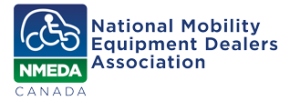May is National Mobility Awareness Month – Vote in Online Contest to Win a Van
TAMPA, FLA. (May 16, 2016) – More than 18 million Americans and Canadians have mobility issues with six percent being veterans. Many more are seniors who grow into their disability. Just because someone is in a wheelchair or a scooter, getting around town and living an active mobile lifestyle is still a possibility. There are numerous mobility options available for people with disabilities that can make driving and riding in a vehicle a more pleasurable experience, non-profit member organization National Mobility Equipment Dealers Association (NMEDA) can help locate mobility resources. May is National Mobility Awareness Month, and you can enter to win one of three wheelchair accessible vehicles by visiting www.mobilityawarenessmonth.com.
When learning a new skill or hobby, there may be a time of challenge. In the same way, a new wheelchair user, especially one beginning to use a minivan, SUV or truck that is wheelchair accessible, can experience difficulties. But, with the help of NMEDA’s Quality Assurance Program (QAP) dealers and Certified Driver Rehabilitation Specialists (CDRS), you can be on your way to moving forward with ease. Here are some ways you can think about the use of your wheelchair accessible vehicle that will help you.
Consider Your Environment
When shopping for a wheelchair accessible vehicle or mobility equipment, factor in where you will be using your vehicle. This purchase is an investment, so keep in mind the weather conditions you will have to face and the routine maintenance needed for your minivan, SUV, car or truck. Besides your environment, consider your present and potential health changes for future conditions. Transferring into and out of a transfer seat if you are a driver is great for someone with upper body strength but can get tiresome and not possible if your conditions worsen.
Mobility Solutions
A popular mobility solution for those who have a wheelchair accessible vehicle is a transfer or a turning seat that allows a person with a disability to move from their wheelchair and drive a vehicle from a specialized driver’s seat. There are different types of transfer seats including a 6-way and 4-way power seat base. The 4-way power seat base is a motorized seat that moves forward and backward. Some 4-way systems have the capability of moving up and down. The 6-way seat base has all of the functions of the 4-way power seat base, plus motorized swivel movement capabilities. If you are a passenger or a driver, there are also turning seats available that swivel outside the vehicle and down to make the transfer easier.
It is also possible to drive from a wheelchair. There are seat bases that can be removed allowing space for a wheelchair. The removable seat bases can then be stored in the rear of the vehicle. For those who sit higher up in a wheelchair, wheel wells and automatic power pans can be installed to lower the wheelchair, and adjust their line of sight.
Seating restraints are available for securing a person or wheelchair in place in the vehicle. There are restraint options such as chest harnesses and lateral trunk supports to support those with diminished trunk and musculature balance. No matter what type of seat or safety restraint is being used, it is always imperative to use a seatbelt when in a moving vehicle. Do not depend on wheelchair locks alone for safety in the event of an accident.
About National Mobility Awareness Month: May is National Mobility Awareness Month and is the annual celebration that encourages seniors, veterans, caregivers and people with disabilities to enjoy active, mobile lifestyles. Founded in 1989 as a not-for-profit trade association, the National Mobility Equipment Dealers Association (NMEDA) supports the awareness month with the assistance of approximately 600 members including mobility equipment QAP dealers, manufacturers and driver rehabilitation specialists located in the United States and Canada dedicated to expanding opportunities for people with disabilities. For updates, please visit MobilityAwarenessMonth.com, as well as Facebook, Twitter (@NMEDAcom) and Pinterest.
